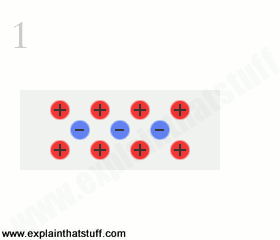



| We share this discussion about Piezoelectricity as it relates to how it manifests in Orgone pieces. As the resin hardens it squeezes the crystals, thus creating a Piezoelectric effect. You can find the original article on Explain That Stuff. |
| You've probably used piezoelectricity (pronounced "pee-ay-zo-electricity") quite a few times today. If you've got a quartz watch, piezoelectricity is what helps it keep regular time. If you've been writing a letter or an essay on your computer with the help of voice recognition software, the microphone you spoke into probably used piezoelectricity to turn the sound energy in your voice into electrical signals your computer could interpret. If you're a bit of an audiophile and like listening to music on vinyl, your gramophone would have been using piezoelectricity to "read" the sounds from your LP records. Piezoelectricity (literally, "pressing electricity") is much simpler than it sounds: it just means using crystals to convert mechanical energy into electricity or vice- versa. Let's take a closer look at how it works and why it's so useful! What is Piezoelectricity? Squeeze certain crystals (such as quartz) and you can make electricity flow through them. The reverse is usually true as well: if you pass electricity through the same crystals, they "squeeze themselves" by vibrating back and forth. That's pretty much piezoelectricity in a nutshell but, for the sake of science, let's have a formal definition: Piezoelectricity (also called the piezoelectric effect) is the appearance of an electrical potential (a voltage, in other words) across the sides of a crystal when you subject it to mechanical stress (by squeezing it). In practice, the crystal becomes a kind of tiny battery with a positive charge on one face and a negative charge on the opposite face; current flows if we connect the two faces together to make a circuit. In the reverse piezoelectric effect, a crystal becomes mechanically stressed (deformed in shape) when a voltage is applied across its opposite faces. What Causes Piezoelectricity? Think of a crystal and you probably picture balls (atoms) mounted on bars (the bonds that hold them together), a bit like a climbing frame. Now, by crystals, scientists don't necessarily mean intriguing bits of rock you find in gift shops: a crystal is the scientific name for any solid whose atoms or molecules are arranged in a very orderly way based on endless repetitions of the same basic atomic building block (called the unit cell). So a lump of iron is just as much of a crystal as a piece of quartz. In a crystal, what we have is actually less like a climbing frame (which doesn't necessarily have an orderly, repeating structure) and more like three-dimensional, patterned wallpaper. In most crystals (such as metals), the unit cell (the basic repeating unit) is symmetrical; in piezoelectric crystals, it isn't. Normally, piezoelectric crystals are electrically neutral: the atoms inside them may not be symmetrically arranged, but their electrical charges are perfectly balanced: a positive charge in one place cancels out a negative charge nearby. However, if you squeeze or stretch a piezoelectric crystal, you deform the structure, pushing some of the atoms closer together or further apart, upsetting the balance of positive and negative, and causing net electrical charges to appear. This effect carries through the whole structure so net positive and negative charges appear on opposite, outer faces of the crystal. The reverse-piezoelectric effect occurs in the opposite way. Put a voltage across a piezoelectric crystal and you're subjecting the atoms inside it to "electrical pressure." They have to move to rebalance themselves—and that's what causes piezoelectric crystals to deform (slightly change shape) when you put a voltage across them. How Piezoelectricity Works Here's a quick animation showing how piezoelectricity occurs. It's somewhat simplified, but it gives you the basic idea: Animation showing how piezoelectric charges appear when you press a crystal. 1. Normally, the charges in a piezoelectric crystal are exactly balanced, even if they're not symmetrically arranged. 2. The effects of the charges exactly cancel out, leaving no net charge on the crystal faces. (More specifically, the electric dipole moments—vector lines separating opposite charges—exactly cancel one another out.) 3. If you squeeze the crystal (massively exaggerated in this picture!), you force the charges out of balance. 4. Now the effects of the charges (their dipole moments) no longer cancel one another out and net positive and negative charges appear on opposite crystal faces. By squeezing the crystal, you've produced a voltage across its opposite faces—and that's piezoelectricity! What is Piezoelectricity Used For? There are all kinds of situations where we need to convert mechanical energy (pressure or movement of some kind) into electrical signals or vice-versa. Often we can do that with a piezoelectric transducer. A transducer is simply a device that converts small amounts of energy from one kind into another (for example, converting light, sound, or mechanical pressure into electrical signals). In ultrasound equipment, a piezoelectric transducer converts electrical energy into extremely rapid mechanical vibrations—so fast, in fact, that it makes sounds, but ones too high-pitched for our ears to hear. These ultrasound vibrations can be used for scanning, cleaning, and all kinds of other things. In a microphone, we need to convert sound energy (waves of pressure traveling through the air) into electrical energy—and that's something piezoelectric crystals can help us with. Simply stick the vibrating part of the microphone to a crystal and, as pressure waves from your voice arrive, they'll make the crystal move back and forth, generating corresponding electrical signals. The "needle" in a gramophone (sometimes called a record player) works in the opposite way. As the diamond-tipped needle rides along the spiral groove in your LP, it bumps up and down. These vibrations push and pull on a lightweight piezoelectric crystal, producing electrical signals that your stereo then converts back into audible sounds. Piezoelectricity is also used, much more crudely, in spark lighters for gas stoves and barbecues. Press a lighter switch and you'll hear a clicking sound and see sparks appear. What you're doing, when you press the switch, is squeezing a piezoelectric crystal, generating a voltage, and making a spark fly across a small gap. |
